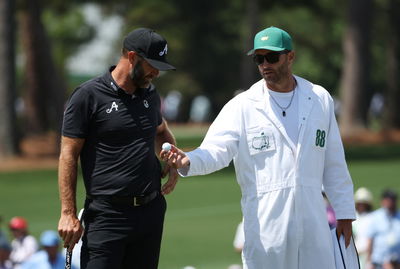Callaway Rogue drivers: Interview with Dr Alan Hocknell
Callaway Rogue and Rogue Sub Zero: Hear from the R&D guru at callaway.

Dr Alan Hocknell is senior vice president of reseach and development at Callawy Golf.
FIRST LOOK: CALLAWAY ROGUE DRIVERS
Explain the design philosophy behind Rogue Drivers?
Rogue represents a different idea of optimising ball speed, aligned to maximising forgiveness, and to achieve this we had to dramatically break away from our own industry-leading design protocols to effectively ‘re-invent’ the driver. Of course, our first challenge was actually designing a product that surpassed Epic, the #1 Selling Driver in Golf.
Rogue has a lot of the same ingredients as Epic, but the development journey of Rogue is anything but evolutionary. Even when we were finalising the first Jailbreak technology that went into Epic, we had already started a great number of experiments with Jailbreak and different arrangements of it, and not just two vertical titanium bars either!
What we have in Rogue is the result of this exhaustive research and a new ballspeed recipe the Callaway R&D team calls ‘Jailbreak Effect’ – specifically how the next generation Jailbreak hourglass-shaped titanium rods work in tandem with our proprietary X-Face VFT Technology in the face and deliver even more performance than Epic.
The synergy of fast face design, revolutionary Jailbreak and extraordinary forgiveness is a giant leap forward from Epic to Rogue.

What are the key benefits?
It was a huge effort, but what we have created in Rogue is a trio of drivers – Standard, Draw and Sub Zero – that all surpass Epic in generating more ball speed, without compromise. Rogue Drivers are also some of our most forgiving ever, so every level of golfer can really see, and enjoy, the benefits.
We have not compromised on any area of performance with Rogue, breaking free of previous design constraints, if you like. Fans of Epic will notice we have taken the sliding weight track and carbon composite structure away from the sole, and have gone for a more direct fitting solution which will make custom-fitting easier to achieve. Golfers trying Rogue for the first time will quickly see which driver is a direct fit for them.
Where does this position Epic?
The important thing to say is that Callaway will never stop innovating. If we discover technologies that push performance forwards, we will always look to share these with our loyal customers as soon as possible. Of course, our emphasis as a company will undoubtedly switch from Epic to Rogue when it is launched – it is sure to be used by many of our Staff Professionals on worldwide Tours (although some may still prefer Epic), it will be very prominent in- store and we will certainly be saying Rogue is the best driver we have ever made because, quite honestly, it is.
However, there is still a very clear place for Epic, particularly in the custom-fitting environment where some players will wish to spend more time seeking what we call a ‘high fidelity’ fitting, using the adjustable sliding weight of Epic (which doesn’t feature in Rogue). Some golfers may also have a head shape preference towards Epic, as the footprint is not quite as large as Rogue.
Golfers may also have friends that play Epic, and they have seen the performance advantages, so Epic is certainly still alive and well. Let’s also not forget, Epic is currently the #1 Selling Driver in Golf, and that speaks volumes for its performance and appeal.

Looks-wise the Rogue Drivers look bigger than Epic. Are they?
Visually they look larger, but are still 460cc. Rogue is stretched in the face to back dimension and also stretched, albeit slightly, in the toe to heel dimension.
For this look to happen in a conforming head we had to create a slightly flatter crown shape, particularly when you compare it to Epic. We wanted to make sure that it was obvious to consumers that the Rogue Driver family had more forgiveness than Epic and that meant putting the weight further away, and back, from the centre of the head from a mass placement perspective.
In terms of overall scale as seen from the address position, the new Standard Rogue Driver has similarities to the Epic Sub Zero, whereas the Rogue Sub Zero has more in common with the Epic Standard.
Why is there no sliding weight track on Rogue Drivers?
The adjustable sliding weight track is a visually obvious technology that people buy into, and you may see it in future Callaway Drivers again, but we wanted to have a point of difference between Epic and Rogue.
The use of a weight track adds a significant amount of fixed weight to a driver so by taking it away we have much more flexibility in the design process. Primarily, we can make the forgiveness dimensions of the head much larger. Our consumer research proved there is also a type of player out there that doesn’t necessarily want all the nuances of sliding weight technology, and we see a lot of golfers that either have the sliding weight fixed in either the neutral position or pushed to the bottom to get maximum draw benefits.
This insight was the basis of the three-driver Rogue range, in Standard, Draw and Sub Zero. We wanted the standard Rogue Driver to have the same characteristics as the standard Epic locked in its neutral position, but with much greater MOI (resistance to twisting). We then wanted to develop a separate Rogue Draw Driver that had two clear advantages over Epic in that it had much greater MOI and it has much more draw bias than Epic, even compared to Epic with its adjustable weight locked in the full ‘draw’ position.
Rogue may be less ‘high fidelity’ in terms of fitting, but the benefit is that one driver gets significantly more draw bias and MOI, one gets more MOI in a more neutral setup. The third, the Rogue Sub Zero Driver, can dial in more/less driver spin, via interchangeable front/back weighting, which directly influences ball flight trajectory, something the more accomplished player is seeking.
Importantly, all three models are hugely forgiving.

How have the aerodynamics experts at Boeing helped?
We knew we wanted the dimensions of the head to be larger, but as soon as you do that you amplify the aerodynamic issues in terms of the drag the larger shape creates on the downswing.
Boeing started with the fundamental first principles of what happens with airflow during the process of a golf swing, and began by robotically swinging spheres on the end of golf shafts. These spheres were of identical weight, but different diameters, and the Boeing team had to work with the Callaway R&D experts to make these out of various materials to get all the elements to be equivalent, other than size.
By doing this we were able to undertake more fundamental analysis because spheres are a more analytically trackable shape to aerodynamically compare. What Boeing was looking for was where the airflow then separates from the surface of the sphere, in which parts of the sphere this happened, and at what points during the swing. From here we were able to establish how crucial the transition from the face of the Driver into the crown was and, subsequently, the radius of the transition between these areas in Rogue is softer, and more generous, than it would otherwise have been.
Air effectively stays closer to the surface of the Rogue Drivers for longer, reducing drag.
What does this mean to the golfer?
If you were swinging at 98mph, for example, you might now swing and 100mph with Rogue, with no additional effort. If that was the case, your ball speed would roughly increase by 1.5 times that, about 3.5mph more ball speed, and that is very significant.
In distance terms, that could increase a golfer’s yardage off the tee by 5-6 yards. If you look at the design of the Rogue head as a whole, and all the effort that has gone into the Jailbreak Effect, we could have lost all the benefits if we had not optimised aerodynamics, it’s that important.

How does the design of the Rogue head unlock more distance?
We knew we had Jailbreak working well in the first generation of its design in Epic, and we were happy with the ball speed gains we were seeing, but the work with Rogue was focused on how we optimised the relationship between the second generation of hourglass-shaped Jailbreak and the face.
Rather than focusing on the structural benefits of the cast titanium bars in isolation, we worked hard on the relationship between the bars and face, and what they collectively did to ball speed.
What the Jailbreak Effect allowed us to do was re-study how we create face flexibility and through X Face VFT Technology, Rogue Drivers now have the most flexible face we have ever had in the ‘conforming driver’ era, with the most ball speed. Of course, Callaway has used variable face thicknesses for a long time, and had them with the ‘X’ shape in the middle before, but we have never had one that is this aggressive, in terms of its lightest overall weight, thinnest area around the perimeter and the outer reaches of the face, and slightly thicker middle.
Jailbreak sits at the heart of the distance recipe. It is Jailbreak’s head-stiffening properties that allow us to have a more flexible face, create more energy in the direction of impact, and still remain conforming to the Rules of Golf.

Can you categorise which Rogue Driver will suit a certain type of player?
The Standard Rogue Driver sits at the centre of the market. It is what people would expect; relatively low spin, high forgiveness, high ball speed from a large part of the face, and probably the model most people will fit into.
However, a lot of golfers generate significant levels of side-spin and to counter this the Rogue Draw has all the advantages of the Standard model, but with more rightto-left shot-shaping capability/correction bias, thanks to added internal heel weighting and a 5g external screw.
Finally, in Rogue Sub Zero we have a driver for golfers that have a tendency to generate too much backspin. The driver has a more neutral centre of gravity bias - it doesn’t have much draw capability - and that starts to point it in the direction of better player who hits the centre of the face more often.
However, not always… …We found a number of players have what we call an ‘iron-dominated’ swing that hits down on the ball quite nicely with irons, but they also do that with a driver, which is not very efficient. This could be an average ability golfer that has too much driver spin. The Sub Zero still has lots of forgiveness, so it could be for this type of player to counteract this fault.
How does the triaxial carbon crown assist the performance of Rogue Drivers?
Its role is important. It is the largest carbon crown we have had in a Callaway Driver, so the larger the crown, the bigger the weight-saving win. It is similar to the material used in Epic, the fibre arrangement is the same, but the resin is completely different.
It is a much stiffer epoxy ensuring maximum stiffness at the lowest possible weight.

Have Tour players influenced the design of Rogue Drivers?
Staff Professionals have been involved in the development of Rogue, and particularly in the shape development of Sub Zero. Through the design phases we would often take parts out to Tour and have players hit them, and even before that, we would take wax models out, which looked like real drivers, and get them to compare shape and scale.
We are pretty confident that when the time comes for launch, there will be a pretty rapid conversion from Epic and other Callaway models. It won’t be 100%, but even the best players in the world will see a clear benefit. Callaway Staff Professionals will also get a few extra options. They will undoubtedly have a preference for the Rogue Sub Zero shape, so we have produced three or four variants with different spin levels, and varying amounts of fade bias, to capture the idiosyncrasies you can often find on Tour.
How important is custom-fitting to pinpointing your perfect Rogue Driver?
Undoubtedly, the optimum way to find the best Rogue Driver for your game is to get it custom-fitted. You are taking a big guess, and may be leaving a lot of opportunity behind, if you don’t. This will be even more apparent if you have not upgraded your driver in the past three years as driver configurations have changed, including the relationship between loft, spin and forgiveness.
It is highly likely you will not fit into a new driver labelled the same as the one you currently own, if you’ve owned it for a while.
How do you decide on shaft choice?
It is a balancing act in many ways. The world has gone from a driver being supplied with one stock shaft option to the other extreme when you can offer a customer many options. We have offered 20 in the past, with no up-charge, and it has led to a lot of consumer confusion. What we have tried to do with Rogue is offer a selection that is more manageable for everyone in terms of how we work operationally, and what the retailer and the consumer needs to understand. Now we have one premium shaft option in each of the key weight ranges; 40g, 50g, 60g, 70g and 80g, and picked our favourites matched to the Rogue Drivers in each of those ranges. Some are all-new and some have been developed from specifications we gave to the shaft manufacturers. We also offer the ‘real-deal’ 70g and 80g Tour shafts - Project X Even Flow and HZRDUS - because we know that is an important option for better players.
Sponsored Posts
Latest News










